In-depth analysis of Flashbots’ investment logic, technical framework, market size, and major risks.
Comprehensive analysis of Flashbots' investment logic, technical framework, market size, and key risks.Author: Elma Ruan; Source: WJ3B Web3
Project Introduction
Flashbots is a research and development organization aimed at mitigating the negative impact of Maximal Extractable Value (MEV) on blockchains, especially Ethereum. Their main goal is to create a permissionless, transparent, and sustainable ecosystem for MEV through products like MEV-Boost. Future MEV development should focus on cross-chain MEV capture, minimizing value loss, minimizing potential negative impact on genuine protocol users, and ensuring fair distribution among participants.
Author
- Mantle Network 20,000-word research report From technical features to token models, in-depth understanding of modular Layer2 new stars
- Model interpretation SOL unlocking market pressure will not bring massive selling pressure. This is a difficult but healthy reset.
- Coin Center Research Director Tornado Cash’s latest allegations appear to contradict Financial Crimes Enforcement Network’s documents.
Elma Ruan, Senior Investment Researcher at WJB, holds dual master’s degrees in marketing/finance from an Ivy League school and has 5 years of experience in Web3. She specializes in DeFi, NFT, and other various tracks. Before entering the crypto industry, she worked as an investment manager at a large securities firm.
1. Research Points
1.1 Core Investment Logic
Maximal Extractable Value (MEV) is a small part of the underlying infrastructure closely related to transactions within a block. It has a high-income effect, with income increasing in proportion to the complexity of transaction scenarios and relatively low risk. Solving the MEV problem is an important part of Ethereum’s development roadmap, aiming to ensure reliable, fair, and trusted neutral transactions and address the MEV problem. Future MEV development should focus on cross-chain MEV capture, minimizing value loss, minimizing potential negative impact on genuine protocol users, and ensuring fair distribution among participants.
When it comes to MEV, various strategies such as frontrunning, sandwich attacks, and transaction tracking often come to mind. These strategies can potentially result in unfair outcomes for certain participants in the blockchain ecosystem, harming the interests of ordinary users. The founders of Flashbots believe that the MEV problem is also an important issue in the Ethereum ecosystem, which can lead to unfair trades and market distortions. Therefore, the founders created the Flashbots project to provide a trusted and neutral communication channel for the Ethereum ecosystem, enabling private communication between miners and other participants to address the MEV problem. The core infrastructure of Flashbots is the relay, which collects transaction bundles from different participant networks and forwards them to miners. The relay can verify the validity of transactions and prevent the occurrence of malicious transactions. At the same time, the relay can also help miners better utilize MEV, thereby increasing their profits.
The pairing between users and searchers is achieved through the Flashbots service. Users can selectively expose their transaction information to Flashbots. Searchers bundle and submit these transaction information to Block Builders to construct the entire block, which helps searchers conduct arbitrage more efficiently. If users agree, arbitrageurs can share a portion of the MEV profits with users, creating a win-win situation. This mechanism also provides a fair bidding process for other arbitrageurs, who can obtain profits by offering higher prices, avoiding transaction failures and excessive gas fees. Furthermore, by filtering out failed transactions, it reduces the occupancy of on-chain space, thereby alleviating congestion issues to some extent and achieving multiple wins.
In general, it is beneficial for all parties involved:
Proposers: By collaborating privately with Searchers, Proposers can be prioritized and gain more benefits.
Searchers: Using Flashbots, they can avoid resource waste, save costs, and obtain more transaction information.
Transaction users: They can avoid interference from malicious behavior when initiating transactions and reduce losses due to operational errors.
Flashbots: By obtaining exclusive transaction information provided by users and Searchers, Flashbots can gain more profit opportunities and become stronger.
However, Flashbots also have some disadvantages. Firstly, Flashbots’ relays require a large amount of computational resources and bandwidth, which may cause performance issues. Secondly, Flashbots needs sufficient support from participants, otherwise it may not be effective. This requires Flashbots to establish cooperative relationships with other participants in the Ethereum ecosystem to ensure widespread adoption and support for Flashbots. Finally, although Flashbots is currently a non-profit organization, it still needs to submit transactions to centralized Flashbots servers, which may pose some centralization risks.
In the industry context, the emergence of Flashbots is a positive signal. As the cryptocurrency market continues to develop, the MEV problem has become increasingly serious. Flashbots’ solution provides a feasible solution for the Ethereum ecosystem to help alleviate the negative impact of the MEV problem. The fair and market-oriented nature of MEV provides predictable returns for the LSD protocol and Ethereum stakers, promoting the growth of Ethereum staking and the adoption of the LSD protocol for MEV solutions. At the same time, the fair and market-oriented nature of MEV also promotes the growth of on-chain activity, improves the user experience on-chain, drives the adoption of MEV products, and creates a virtuous cycle of demand for Ethereum staking. In addition, market-oriented MEV protocols can better allocate benefits and promote the overall growth of the Ethereum ecosystem.
In the long run, the MEV track has broad prospects. Although it is currently in its early stages, there are already signs of a winner-takes-all effect. Flashbots has built the foundation for the rapid growth of MEV and provides many opportunities for the future.
1.2 Valuation

The valuation of the Flashbots project has reached $1 billion. According to The Block’s report, the Ethereum infrastructure service provider completed a Series B financing of $60 million in July 2023.
2. Project Overview
2.1 Business Scope
The business scope of Flashbots mainly includes Flashbots Auction, Flashbots Protect, Flashbots Data, MEV-Boost, and MEV-Share. Flashbots Auction is a permissionless, transparent, and fair ecosystem designed to efficiently extract maximum benefits and protect transaction frontrunning. Flashbots Protect provides secure and user-friendly transaction methods to prevent malicious transactions and allows users to share MEV. Flashbots Data provides tools for analyzing Ethereum MEV, stored in a Postgres database. MEV-Boost can enhance validator efficiency, promote Ethereum competition and decentralization. MEV-Share is an open-source protocol that enables users, wallets, and applications to internalize the maximum profit loss (MEV) created by their transactions.
2.2 Development History and Roadmap

Future Roadmap:
SUAVE is a project called “Single Unified Auction for Value Expression” that aims to address the issue of Miner Extractable Value (MEV) by building a decentralized transaction serialization layer. SUAVE consists of three main components: a universal preference environment, a best execution market, and a decentralized block construction network. SUAVE aims to empower users and maximize decentralization of public blockchains. It is an independent network that can serve as a plug-and-play mempool and decentralized block builder for any blockchain. Flashbots is one of the creators of SUAVE, and in the SUAVE whitepaper, Flashbots explicitly states that they will continue to improve SUAVE and include it in future important plans.
– Q2 2021: Release the first version of SUAVE, supporting mainstream public chains such as Ethereum and BSC.
– Q3 2021: Support more public chains, including Polygon, Solana, etc.
– Q4 2021: Support cross-chain MEV solutions and more MEV capture strategies.
– 2022: Launch the second version of SUAVE, supporting more MEV capture strategies and higher throughput.
– 2023: Plan to release the SUAVE testnet chain to start testing its new features.
– Future: Further enhance the security and decentralization of SUAVE, support more public chains and cross-chain solutions.
In addition, SUAVE’s future plans include collaboration with other MEV-related projects and organizations to promote the development and decentralization of MEV. SUAVE also plans to achieve decentralization through community governance to ensure its long-term sustainability and development.
2.3 Team Overview
2.3.1 Overall Situation
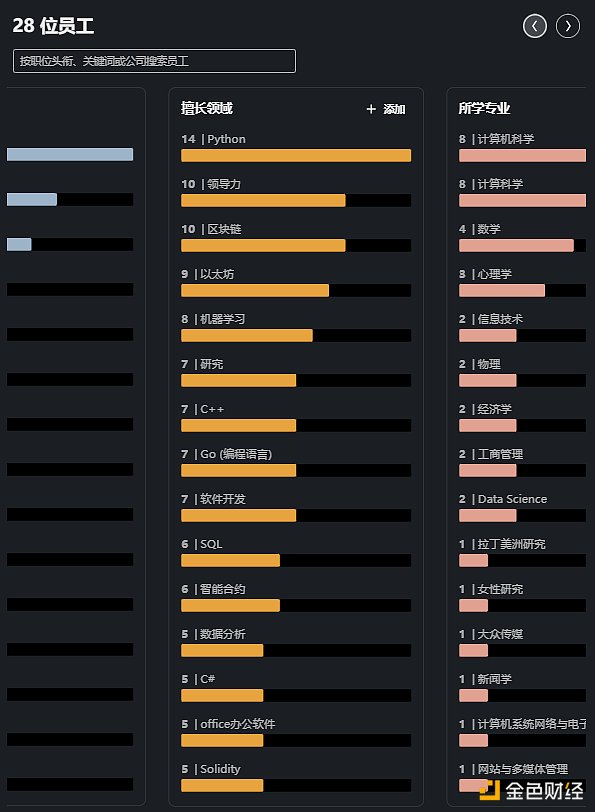
According to LinkedIn, Flashbots currently has 28 employees, most of whom are concentrated in fields such as computer science, mathematics, psychology, and economics. These employees have a wide range of professional backgrounds and expertise in various technologies and domains, including but not limited to Python, blockchain, machine learning, and C language. Their expertise and skills enable them to tackle complex technical challenges in the Ethereum ecosystem and make positive contributions to the research and development of the Flashbots project.
2.3.2 Founders

Philip Daian Co-founder
In addition, Stephane Gosselin, co-founder of Flashbots, resigned from his position in October 2022 due to differences with the team regarding the review process.
Alex Obadia, a former co-founder and top strategy researcher at Flashbots, left the company on June 20, 2023, for personal reasons.
2.3.3 Core Members

Andrew Miller, Director of Trusted Execution Environment and SUAVE Research
Miller is well-known for his research on cracking Intel SGX code. He has served as the Associate Director of the Initiative for Cryptocurrencies and Contracts (IC3). Miller plans to take a temporary leave from his position as an assistant professor at the University of Illinois, where he currently focuses on electrical and computer engineering.

Hasu Flashbots, Director of Strategy
Hasu serves as a strategic advisor for the leading liquid staking protocol, Lido, and as the Director of Strategy for the Flashbots research and development team, which protects users from MEV impact. Currently, he spends approximately 90% of his time on Flashbots and 10% on Lido. He is also a research collaborator at LianGuairadigm investment company, co-founder of Deribit Insights, and has represented MakerDAO. He educates and promotes industry development through writing, social media, and podcasts.
2.4 Financing Situation
The company was founded in 2020 and has gone through two rounds of financing. Initially, the company received seed funding from LianGuairadigm, with the investment amount undisclosed. In 2023, the company conducted a Series B financing round, raising $60 million, with LianGuairadigm being a significant investor in the round.

3. Business Analysis
3.1 Target Users
The main target users of Flashbots include:
1) Arbitrage and liquidation bots, DeFi traders: They profit by finding extractable value on the Ethereum chain and bundling these transactions together to provide to Flashbots’ builders.
2) Ethereum Dapps with complex use cases: These Dapps leverage the functionality provided by Flashbots to optimize the execution of their transactions, improving efficiency and returns.
3) Professional builder organizations: These organizations select the most profitable transactions from the transaction bundles sent by searchers and package them into complete blocks, which are ultimately sent to validators through the relay. Currently, there are few active builders in the market, and a few organizations dominate the market share.
4) Miners: Validators of ETH2.0 responsible for proposing blocks to the network and adding them to the chain.
5) Everyday Ethereum users: They can directly interact with Flashbots and execute their transactions using the tools and interfaces provided by Flashbots.
3.2 Business Categories
Flashbots’ business scope mainly includes the following aspects:
1) Flashbots Auction: Provides a permissionless, transparent, and fair ecosystem for efficiently extracting MEV (Miner Extractable Value) and protecting transactions from frontrunning while maintaining the ethos of Ethereum. Flashbots Auction provides a private channel between Ethereum users and validators to effectively convey transaction preference order within a block.
2) Flashbots Protect: Provides Ethereum users with a user-friendly, secure, and powerful transaction environment. It is configurable and allows users to choose which builders to send transactions to and customize MEV sharing settings according to their needs. It also provides protection against frontrunning behavior, ensuring that transactions are not captured by malicious transactions in the public Mempool. If a transaction creates MEV, users can receive rewards through the MEV-Share mechanism.
3) Flashbots Data: Provides a tool for MEV inspection on Ethereum, allowing for analysis of blocks, including validator payments, token transfers and profits, exchanges, and arbitrage data. All data is stored in a Postgres database for querying and analysis purposes.
4) MEV-Boost: The main purpose is to enhance the efficiency of Ethereum validators by accessing a competitive block building market. The MEV-Boost mechanism separates the roles of proposers and block builders, thereby promoting decentralization and censorship resistance in the Ethereum network.
5) MEV-Share: An open-source protocol that allows users, wallets, and applications to internalize the MEV they generate from their transactions. It is neutral, meaning that any searcher can participate, regardless of specific block builders.
In summary, Flashbots primarily involves the business scope of Flashbots Auction, Flashbots Protect, Flashbots Data, MEV-Boost, and MEV-Share, aiming to improve the efficiency of MEV, protect transaction security, and provide competitive block building.
3.3 Business Details
Flashbots’ business mainly involves four parts: Searchers, Relays, Builders, and Proposers. These roles play different roles and have different responsibilities in the process of a single block being produced.
The following is the process and responsibilities of these roles in the process of producing a single block:
Builders: Builders create blocks by collecting transactions from users, searchers, or other order flows. Their goal is to build blocks with maximum executable value, aiming to maximize their own and proposers’ MEV.
Relays: Relays are trusted third parties that serve as bidirectional communication channels connecting proposers and builders. They act as validators, verify the validity of blocks, and calculate the amount to be paid to proposers.
Proposers: Proposers are Ethereum proof-of-stake validators. After receiving block headers and payment values submitted by relays, they evaluate all received bids and choose to sign the block header associated with the highest payment.
Searchers: Searchers monitor the public transaction pool and the Flashbots private transaction pool, looking for the optimal transaction order to maximize their interests and provide them to builders.
The operation process is as follows: Builders create blocks and submit them to relays. Relays verify the validity of blocks, calculate the amount to be paid to proposers, and send block headers and payment values to the current proposer. Proposers evaluate the received bids, choose to sign the block header associated with the highest payment, and send it to relays. Relays publish the block using beacon nodes and return it to the proposer. Finally, rewards are distributed to builders and proposers in the form of transactions and block rewards within the block.
1. Flashbots Auction
Flashbots Auction is an open, transparent, and fair ecological auction mechanism designed to efficiently capture MEV and prevent frontrunning, in line with the Ethereum philosophy. It enables efficient communication of the transaction priority within a block through a private communication channel between Ethereum users and validators.
Flashbots Auction was initially based on mev-geth and mev-relay. In PoS Ethereum, it is built on top of Mev-Boost, which implements Ethereum’s “proposer-builder separation”.
However, it also exposes a series of negative effects caused by MEV:
1) Inefficient communication of transaction order between PGA bot operators and POW miners leading to network and congestion.
Regular users bear the cost of high gas fees and scarce block space.
2) The MEV incentive mechanism poses a certain threat to the security of Ethereum consensus. It encourages on-chain history reorganizations to capture past MEV and at the same time promotes centralization of transaction routing for better privacy protection, latency control, and transaction order control.
3) Relevant parties are developing permissioned and exclusive transaction routing infrastructure, which undermines Ethereum’s neutrality, transparency, decentralization, and fairness. Flashbots Auction, as an open and democratic choice, aims to reduce the negative effects and security threats mentioned above.
Working Principle
Flashbots Auction is a system that provides a private transaction pool and a sealed block space auction mechanism. The system allows block producers to entrust others to find the optimal way to construct blocks in an untrusted environment.
In a conventional Ethereum transaction pool, users broadcast transactions to the public P2P network and specify the gas price, indicating the fee they are willing to pay for computation on the Ethereum network. After receiving the transactions, block producers sort them based on gas price and then use a greedy algorithm (a greedy algorithm is a method for selecting the locally optimal solution, hoping to achieve the globally optimal solution through local optimal choices in computer science) to generate a block that maximizes the revenue through transaction fees. This mechanism combines the characteristics of English auction and all-pay auction, bidding for block space in a public environment, and the highest bidder wins, with all participants sharing the cost.
This mechanism has the following problems:
1) The public transaction pool leads to a bidding war for block space, increasing network load and gas price fluctuations, which is disadvantageous to participants without a foresight bidding strategy.
2) All-pay auction results in failed transactions that were not selected, wasting valuable block space on the blockchain. In addition, bidders underestimate their bids due to execution risks, ultimately causing artificial block space scarcity and reducing validators’ income.
3) Relying solely on gas price mechanism prevents bidding participants from expressing their preferences for transaction order, as they can only compete for the top position in the block. This forces participants to adopt other ineffective strategies to increase their chances of transactions being included in a block, such as sending a large number of useless transactions to occupy block space. This situation leads to waste of public resources and efficiency loss.
On the contrary, Flashbots Auction uses the First-Price Sealed-Bid Auction (FPSBA) mechanism, where participants can communicate specific bids and transaction order preferences through private channels without incurring the cost of unsuccessful bids. This mechanism maximizes the profits of validators, as each transaction has a corresponding bid and validators can choose the highest-profit combination of transactions. At the same time, different participants need to determine their bids based on the expected profits from MEV opportunities, which is essentially a price discovery process that can derive the market value of MEV opportunities. Most importantly, the FPSBA mechanism eliminates the problem of front-running caused by open bidding.
Flashbots Auction Roadmap
The Flashbots team has adopted an incremental approach to decentralize the Flashbots auction architecture. In this process, they will gradually introduce new technologies and improvements to refine the entire architecture.
l Privacy before transaction: Transactions are only made public after being included in a block, excluding intermediaries such as relayers and block producers.
l Failed transaction privacy: Unsuccessful bids will not be included in the block and will not be made public.
l Efficiency: MEV extraction will not cause unnecessary network or link congestion.
l Bundle merging: Merge multiple incoming bundles in a conflict-free manner.
l Irreversible protection: Once a block containing Flashbots bundles is propagated, it is difficult to modify through chain reorganization, preventing temporal attacks.
l Complete privacy: Intermediaries such as relayers and validation nodes cannot see the content of transactions before they are put on the chain.
l Permissionless: No trusted intermediaries to censor transactions.

Technical Architecture
The Flashbots auction architecture introduces a network that consists of three different participants, each responsible for maintaining the necessary parts of this communication channel. Block producers are responsible for constructing complete blocks, which are proposed by validators.
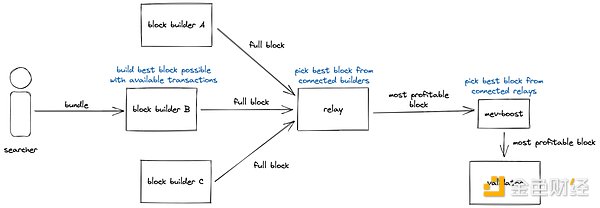
For searchers, searchers refer to Ethereum users who, for various purposes, prioritize using the Flashbots private transaction pool over the conventional P2P transaction pool. These users are responsible for monitoring the on-chain state and sending transaction bundles to relayers.
They can be divided into the following three main categories:
Ethereum transaction bot operators: They need fast and risk-free access to block space, such as arbitrage and liquidation bots.
Ethereum users seeking transaction frontrunning protection: For example, Uniswap traders.
Ethereum DApps with complex use cases: Such as implementing account abstractions or zero-gas transactions.

(Searchers gather information from various channels and create bundles based on this information to send to block producers.)
By directly submitting bundles to block producers instead of using a peer-to-peer network, searchers can achieve “privacy before transaction,” meaning that their transactions are not visible to others in the network. Searchers can express their willingness to pay for the inclusion of transactions in two ways: by setting the gas price for Ethereum transactions or by directly transferring funds to a Coinbase address. Unlike setting gas prices, direct payment can avoid unnecessary failed bid costs and only requires payment when the transaction is successful. This approach ensures transaction privacy and improves economic efficiency.
For Block Builders, they are a group of professionals who receive transactions from users and searchers, and strive to construct the most profitable blocks from these transactions. The constructed blocks will be sent to validators through MEV enhancement relays. Searchers will send bundles to one or more block builders.

(Block builders use bundles from searchers and transactions from the mempool to create blocks)
Relays
Relays are a component of PBS (Periscope Block Scope) and are responsible for hosting blocks from builders for validators to use.
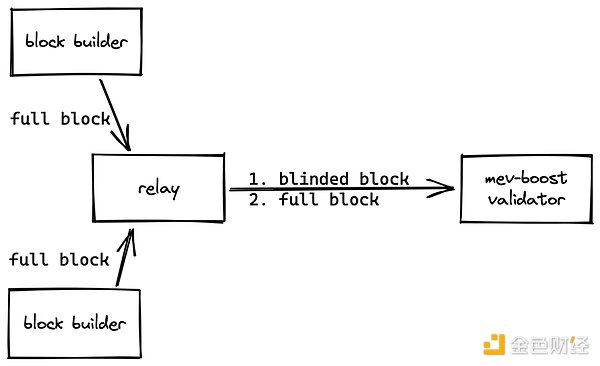
(Relays select the most profitable blocks from their builders and host them for validators to use)
Through MEV-Boost technology, validators can select the blocks with the most profitable potential from multiple relays. Each relay keeps the content of the blocks confidential before validators decide to propose them to the network.
Specifically, relays perform the following steps:
Receive new blocks from block builders.
Send the most profitable blocks to validators when requested.
Validators establish their commitment to propose the complete blocks by signing the block header.
After receiving the signed block header from validators, relays send the complete blocks to validators.
Execute all operations quickly and reliably to ensure validators do not miss the proposal deadline.
Validators/Proposers
In PoS Ethereum, validators are responsible for proposing blocks to the network and appending blocks to the blockchain.
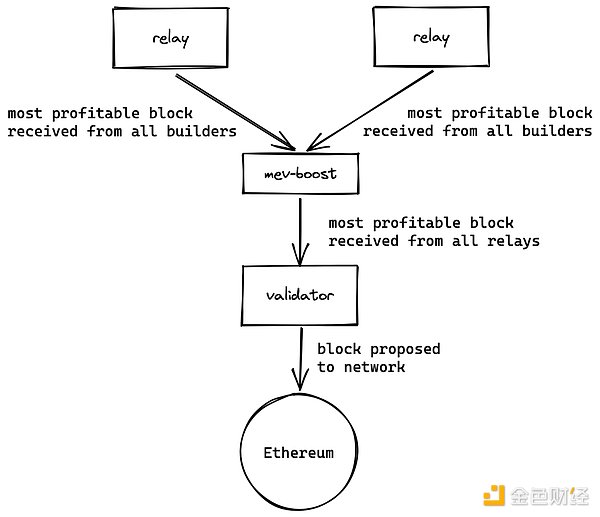
(Validators utilize MEV gains to propose the most profitable blocks from multiple relays)
When block builders generate blocks, the generated blocks are often more profitable if they include MEV transactions that can maximize revenue. Validators can earn higher profits by selecting these blocks with the highest profits. This process is called Mev-Boost, which can boost the earnings of validators.
Bundles
Searchers use Flashbots to submit transaction bundles to block builders for inclusion in blocks. Bundles combine one or more transactions and execute them in the provided order. In addition to transactions from searchers, bundles can potentially include pending transactions from other users in the mempool, and bundles can also selectively choose specific blocks for inclusion.
Bundle Pricing
At a high level, Flashbots’ block builders aim to include the most profit-generating transactions in the blocks they construct. In Ethereum’s PoW mechanism, Flashbots’ block builders achieve the searchers’ maximum profit goal by inserting the bundles from searchers at the top of the block and removing less profitable transactions from the end of the block. In terms of Gas Price, the transactions at the end of the block are the least profitable but still need to be mined by miners. Therefore, for a Flashbots bundle to be considered profitable, it must have a higher Gas Price than the transactions it replaces at the end of the block.
In PoS Ethereum, the experience rule for pricing bundle packages on Flashbots is basically the same; more profitable transactions are usually favored by the block building algorithm. The profitability of bundle packages/transactions is determined by the Gas Price, priority fee, and directly validator payment price used in each transaction.
In the PoS mechanism, bundle packages do not place transactions between bundle package transactions but can be placed anywhere in the block. This means that in addition to bundling transactions into one package, other transactions from the memory pool can also be added to the blockchain. However, transactions in the bundle package are not directly added to the blockchain.
Bundle package sorting formula
Flashbots block builders use a new algorithm designed to generate the most profitable blocks. This design has some important changes to note for searchers:
No longer sorting and including bundle packages based on effective Gas Price, the algorithm optimizes the overall profit of the block.
No longer guaranteed to be executed at the top of the block.
Other transactions (such as transactions from the memory pool) may be implemented between two different bundle packages instead of between transactions within the bundle package.
RPC Endpoint
Advanced users can interact with the RPC endpoint on relay.flashbots.net or one of the following test URLs.
The URL for the bundle package relay is as follows:

Searchers Reputation
During high load periods, Flashbots provides consistent access to Flashbots block builders for searchers with a good performance record. In order to deal with complex layer 7 attacks, various solutions are being explored, one of which is to enhance the Flashbots infrastructure by introducing a searcher reputation mechanism.
EIP-1559 Support
Since mev-geth v1.10.5-mev-0.3.0, Flashbots has started supporting EIP-1559 transactions. For searchers who want to continue using traditional transaction methods, no configuration changes are required. However, EIP-1559 brings significant changes to the base fee of the block, which means that searchers who used to trade with a Gas price of 0 need to make some level of adjustment to their transactions. Nevertheless, searchers still have the opportunity to prioritize fees, either by transferring directly to Coinbase or by paying a Gas price higher than the EIP-1559 base fee. However, regardless, the user’s transaction must include at least the Ethereum Gas Price equal to the base fee.
2. Flashbots Protect
Overview
Flashbots Protect RPC does not track any user information (such as IP address, location, etc.) and does not store or record user information. Flashbots Protect is a user-friendly, secure, and powerful Ethereum transaction method that is suitable for both beginners and experienced users.
It has the following main advantages:
1) Configurability: Users can choose to send transactions to different builders and set MEV shares.
2) Prevent frontrunning: Users’ transactions will not be discovered by sandwich bots in the public memory pool.
3) Obtain MEV rewards: If a user’s transaction generates MEV, the user can get up to 90% of the rewards through MEV-Share.
4) No Failed Transactions: Only when a user’s transaction operation is not revoked or rolled back, will it be included in the transaction. Therefore, users do not need to pay for failed transactions.
MEV-Share (more detailed introduction in the following text)
Through MEV-Share, users have the opportunity to earn up to 90% of the MEV revenue generated through their transactions on exchanges. By default, Protect users will be connected to a sustainable and optimized Stable configuration, which is continuously optimized by Flashbots for better execution efficiency while protecting users from harmful MEV.
Flashbots MEV-Share nodes maintain a stable configuration that is continuously optimized to provide better execution efficiency for users while protecting them from harmful MEV. Users only need to send their transactions to Flashbots Protect to earn revenue. Advanced users can have more precise control over transactions and preferences through the advanced panel or by manually setting their Protect RPC requests.
There are three ways to use Flashbots Protect:
1) Add Flashbots Protect RPC (https://rpc.Flashbots.net) to the user’s wallet, suitable for most users.
2) Send transactions to https://rpc.Flashbots.net using eth_sendRawTransaction.
3) Send transactions to Flashbots using eth_sendPrivateTransaction.
The simplest way to use is to add Flashbots Protect RPC to the user’s wallet and configure which builders to send to, as well as customize the MEV-Share settings.
Accelerating transaction inclusion speed
Transactions sent through Flashbots Protect are by default only shared with Flashbots, as Flashbots only build a portion of the Ethereum blocks. If users want to increase the chances of their transactions being included, they can choose to share their transactions with more builders. Simply select other builders in the options of the “Connect wallet to Protect” button.
Canceling transactions
Transactions submitted to Flashbots Protect will be sent to Flashbots MEV-Share nodes and held for up to 6 minutes there.
Flashbots Protect allows users to cancel pending transactions by submitting a cancellation transaction to Flashbots Protect. When canceling a transaction, users need to send a new transaction that meets the following conditions:
To cancel a transaction, you can submit it using the same address, including the same nonce, sender, and receiver addresses, and the data field should be empty. This cancellation is free and is mainly used to verify the operational permission of the original transaction account. Since canceled transactions are not allowed to enter the blockchain, no fees will be incurred.
Fixing stuck transactions
If a user’s transaction is in the “pending” state or has a very high nonce, the user needs to clear the activity and nonce data in MetaMask. This will cause MetaMask to update the nonce and transaction history from the network. During this process, the user’s funds and keys are safe.
3. Flashbots Data
MEV-Inspect
mev-inspect-py is a MEV detection tool for Ethereum. It can analyze various information in blocks, including validator payments, token transfers and profits, transactions and arbitrage, and so on. All this data is stored in a Postgres database for easy querying and analysis.
The detection of block execution is carried out in the following steps:
Retrieve the trace information, receipts, and block data of the block from the RPC endpoint.
Decoding trace information using a known ABI (Application Binary Interface) to understand its meaning. This involves parsing transaction or event trace data on the blockchain using the specific ABI specification of a smart contract.
Extracting structured objects such as transfer and exchange operations from the decoded trace information.
Storing these structured objects in a database for future querying and analysis.
4. MEV-Boost
MEV-Boost is an open-source middleware software used by validators to access a competitive block construction market. It is developed by Flashbots and aims to achieve a proposer-builder separation (PBS) in Ethereum based on Proof of Stake (PoS). With MEV-Boost, validators can obtain blocks from the builder market. Builders generate blocks with transaction ordering and proposer fees and provide them to validators. By separating the roles of proposers and builders, MEV-Boost encourages more decentralization and censorship resistance in the Ethereum network.
Significance
On Ethereum, MEV has a centralized influence. Without intervention, competition around MEV opportunities could lead to instability in the consensus mechanism and may require the establishment of permissioned communication infrastructure to ensure a balance between searchers, block producers, and validators. For PoS Ethereum, the opportunity to gain MEV becomes more important as the planned reduction in block rewards will make MEV a significant portion of validator income. Validators running MEV-Boost maximize their stake rewards by selling their block space to an open market. It is estimated that validators using MEV-Boost can increase their stake rewards by over 60%.
How it works
PoS node operators need to run three software components: validator client, consensus client, and execution client. MEV-Boost, as an additional component of the consensus client, is an independent open-source software responsible for querying and outsourcing block construction to a network of builders.
Block builders prepare complete blocks, optimize MEV extraction and fairly distribute rewards, and send the blocks to relayers. An instance of MEV-Boost can be configured to connect to multiple relayers.

Relayers aggregate blocks from multiple builders and determine the most profitable block to be submitted to proposers. Then, the proposer’s consensus client receives the most profitable block from MEV-Boost and propagates it to the Ethereum network for validation and inclusion in a block.
5. MEV-Share
MEV-Share is an open-source protocol designed to maximize the executable value generated from internal transactions within users, wallets, and applications. Through an “orderflow auction” mechanism, it allows users to choose to share transaction data with searchers willing to include their transactions in blocks. Users have the freedom to choose how to reallocate the searcher’s bid, whether to themselves, validators, or other participants. MEV-Share is neutral, open to searchers, and does not favor any specific block builder. Its goal is to reduce the centralized impact of exclusive order flow on Ethereum and enable wallets and other order flow sources to participate in the MEV supply chain.
Using MEV-Share is easy. Users simply need to send their transactions to Flashbots Protect and utilize the service of Flashbots MEV-Share nodes. Through MEV-Share, MEV is returned to its original creators: the users. This protocol is scalable and designed in a decentralized manner, allowing searchers to integrate without permission and without favoring any specific block builder.
Users send their transactions to specific MEV-Share nodes, which selectively share transaction information with searchers based on the users’ privacy preferences. Based on this information, searchers submit partial bundles to MEV-Share nodes, attempting to extract MEV from users’ transactions without viewing the complete transaction data. MEV-Share nodes simulate a portion of the bundled transactions submitted by searchers. Then, they send the successful bundle and a condition to the block builder. In other words, MEV-Share nodes help searchers share information about their successful transaction bundles, which means users will receive 90% of the MEV return from their own transactions. This mechanism ensures that users receive fair compensation in the process.
Currently, MEV-Share nodes only accept retrospective operations.
6.REV
After the merger on September 15, 2022, MEV will be changed to REV (Realized Extractable Value).
REV can be divided into the following two parts:

Among them, REVS is the value passed to searchers, and REVM is the value passed to miners. It should be noted that, as described below, REV already includes the cost of opportunity mining (i.e., the actual REV of the opportunity depends on the network gas price when mining).
Searcher’s REV consists of the following parts:

In the transaction that performs the extraction operation, Vout represents the value flowing from the searcher to the blockchain (excluding gas fees); Vin represents the value flowing from the blockchain to the searcher; MEVg represents the gas price of the transaction; MEVs represents the size of the transaction, that is, the total amount of gas consumed. Vout, Vin, and MEVg are denominated in the base network currency (ETH), while MEVs is calculated in gas units. Separating gas fees from Vout helps quantify the extraction cost and is the method for calculating the actual REV.
Here, the term “blockchain” refers to any other address unrelated to the EOA or smart contract controlled by the searcher (corresponding to the smart contract or EOA) that extracts transactions. Identifying these addresses is a heuristic guidance process based on known searcher patterns and may have omissions. In addition, any auxiliary transactions related to MEV extraction (such as “meat” in sandwich attacks) are not part of the variables mentioned above. On the miner side:

Among them, geff represents the effective gas price of transactions that should have been included in the block without exploiting opportunities. Therefore, REV includes the opportunity cost borne by miners for including MEV extraction transactions.
Since transactions in the transaction pool are transient, it is not possible to measure geff solely based on blockchain data and logs. Because Flashbots adopts an approximate method, which also serves as a lower bound for the value realized by miners:

Among them, gtail is the Gas price of the last transaction in the block.

Therefore, even though the roles of miners and searchers are somewhat ambiguous, the extraction cost of opportunities, i.e. the MEV.gtail of the subtractive part, can be clearly determined.
Finally, at this stage, the value distribution between searchers and miners depends entirely on the choice of MEV, which is influenced by other searchers attempting to exploit this opportunity.
3.4 Industry Space and Potential
3.4.1 Background
MEV can be divided according to its classification as follows:
1) Transaction Execution Type:
Pre-transaction MEV: Operations performed before transaction execution, mainly obtaining value through bidding in a public transaction pool or transaction redirection.
Mid-transaction MEV: Value generated during transaction execution, including manipulating the order of transaction queues, transaction reordering, and other operations.
Post-transaction MEV: Operations performed after transaction execution, usually related to interaction with smart contracts on the blockchain, including mining rewards, flash loans, etc.
2) Market Manipulation Type:
Pre-market MEV: Obtaining profits by manipulating the market outside of exchanges, such as information manipulation and collaborative manipulation.
In-market MEV: Obtaining profits through operations and trading activities within exchanges, including market manipulation and stop-loss activation.
Post-market MEV: Obtaining profits through operations after the completion of transactions, such as trade returns and market adjustments.
3) Blockchain Protocol Type:
Contract transactions MEV: Transactions executed using smart contracts to obtain value by manipulating contract logic.
Block mining MEV: Manipulating the order of blocks during the mining process to obtain value.
Solving the MEV (Miner Extractable Value) problem is an important part of the Ethereum development roadmap. On November 5, 2020, Vitalik Buterin, the co-founder of Ethereum, released an updated version of the Ethereum development roadmap, which introduced a new phase called “The Scourge” to ensure reliable, fair, and trustworthy neutral transactions and address the MEV problem. This means that protocols addressing the centralization issue of solving MEV will receive more attention, and the importance of this track will gradually increase.
In the past few years, the development of MEV has gone through different stages. The early stage (2010-2017) was the embryonic period of MEV, mainly concentrated on the Bitcoin network, such as fee sniping and double-spending attacks. The formal birth stage (2018-2019) was a significant growth period for MEV on Ethereum, including the emergence of decentralized exchanges, algorithmic stablecoins, and automated market-making mechanisms on Ethereum, providing more opportunities for MEV.
Currently, there are various solutions in the MEV market, among which Flashbots is the most prominent organization. Flashbots achieves MEV extraction through robot encryption. The launch of its MEV auction platform has received widespread attention and has generated considerable MEV revenue. The market potential of the MEV track is huge. According to data provided by Flashbots, over 206,450 ETH in MEV revenue has been generated before the Ethereum merge, but this is only the revenue accepted by block proposers, and the revenue of searchers has not been calculated. Based on the current market development, the market size of MEV could be infinite. Moreover, the current actual MEV revenue is only a fraction of the potential.
In general, the development prospects of the MEV track are broad. With continuous technological and protocol innovations, the attention to solving MEV issues will further increase, bringing more opportunities and benefits for users and participants.
3.4.2 Market Size
The revenue scale of this field is almost synchronized with the trading volume of the cryptocurrency market. The scale of MEV is influenced by two main factors: there is a positive correlation between arbitrage frequency and price fluctuations, and there is also a positive correlation between arbitrage volume and total trading volume.
Take Flashbots as an example, its total gross extraction profit is 713.95M, which is considered as benign MEV, and it has a positive impact on determining market value, completing core functions of DeFi, and DEX trading volume. The revenue from sandwich attacks is 1206.11M, which is considered as adverse MEV. Most MEV-protected DEXs hope to control and retain this part of the profit.
Using Uniswap, LianGuaincakeswap, and Sushi as anchor points for cumulative fee income ranking, the cumulative fees of these three DEXs amount to 5.21 billion, and the MEV income obtained through Flashbots accounts for approximately 37% of it. In addition to the main DEXs, other DApps, Layer 2 solutions, and alternative layers on Ethereum also generate significant MEV income. To calculate the transmission of these fees throughout the value chain and form the scale of various sub-sectors, it is necessary to analyze the distribution of MEV profits among different participants.
According to Eigenphi’s data, in January and February 2023, MEV searchers obtained $48.3 million from transactions of all users through wallets and RPC, of which $34.7 million flowed to builders, and builders transferred $30.3 million to validators. The profit distribution is as follows: searchers received $7.3 million (17.4%), builders received $4.4 million (10.5%), validators received $30.3 million (72.1%). It can be seen that the majority of profits (72%) are still obtained by downstream validators.
Out of the $48.3 million, $6.3 million was used for the burning of EIP 1559. The priority fees for regular transactions transmitted from wallets and RPC to builders and then to validators amount to $32.554 million. Wallet and RPC regular transactions burned $22.72 million for EIP 1559.
In the bull market of 2021, the overall revenue ceiling reached $476 million. Calculated based on a lower income multiplier of 10 times, the scale of the entire field is close to $5 billion. The scale of each sub-sector can be roughly estimated based on the proportion, with searchers exceeding $1 billion and validators exceeding $3.5 billion.
However, robots participating in on-chain transactions and profiting from them may still incur many costs of failed transactions and other off-chain hedging costs, which are not included in the calculation. In addition, this calculation only considers the income obtained by direct participants and does not take into account the market of indirect participants. In reality, the scale of the entire field far exceeds the above figures.
3.5 Business Data
l Operational Data
Note: Since the merger on September 15, 2022, the project has changed MEV to REV (Realized Extractable Value), which more accurately represents the actual realized and extracted amount compared to the theoretical maximum amount. In simple terms, REV refers to the income earned by miners in the blockchain network, while MEV is a more specific concept that involves the potential value miners obtain from ordering transactions and manipulating certain on-chain activities.
REV:


As of August 31, 2023, the total amount extracted since the merger is 288,829 ETH, and the amount extracted in the past 30 days is 18,860 Ethereum (Searchers’ earnings are not included in the calculation). Since October 2022, the total amount of Ethereum paid to Proposers has been steadily increasing, from 1.6K per week in October 2022 to 287.1K per week in August 2023, an increase of more than 179 times.
REV detailed analysis (the following data sets include statistics on two types of REV attack arbitrage and liquidation captured by mev-inspect-py after the merger)


According to the data, the protocol with the largest proportion of MEV arbitrage is Uniswap V2, accounting for 64.11%. Followed by Uniswap V3, Curve, and Balancer V1. In arbitrage transactions, WETH has the highest proportion, reaching 91.58%. Followed by USDC, USDT, and other currencies. In terms of liquidation, the proportion of Aave protocol is 68.8%, and Compound V2 accounts for 31.2%. The total profit value of liquidation is approximately $1.22 million. In terms of currencies, WETH has the highest proportion, accounting for about 25.09%, followed by USDC, accounting for 24.07%.
It should be noted that due to the incomplete coverage of all token prices denominated in US dollars, the project can only detect about 85% of the total arbitrage volume (denominated in US dollars).
Flashbots Relay Metrics

According to the dataset including the MEV-Boost operation of Flashbots relays on the Ethereum mainnet, it can be observed that the total amount of Ether (ETH) paid to validators in Flashbots MEV-Boost relays is continuously increasing. In November 2022, the block reward reached a peak of 13K ETH per week, and overall, the average ETH paid to validators per week is between 2-4K.
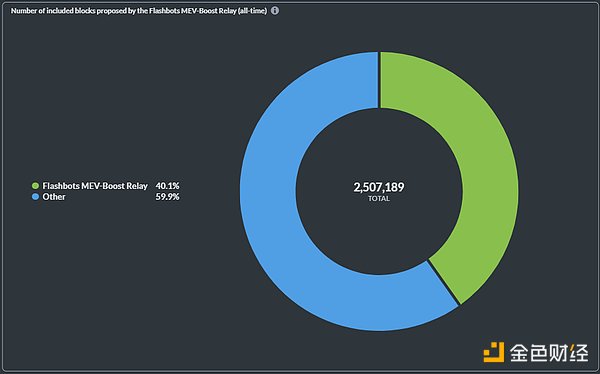
During the entire period, the total number of blocks submitted by MEV-Boost Relay is approximately 2.5 million. Among them, Flashbots accounts for 40.1% of the proportion, while others account for 59.9%.
Flashbots Relay Validator Registration Data:
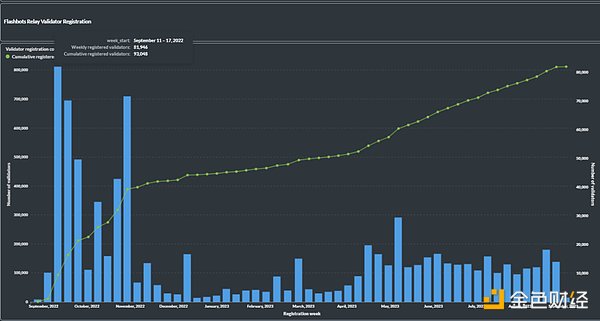
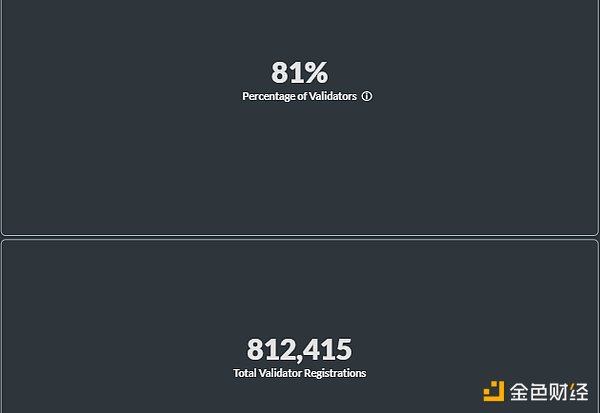
According to the data, 81% of the current total number of validators are registered with Flashbots relays. Currently, the total number of validators is about 810,000. Overall, the number of validator registrations continues to increase. From September to November 2022, the growth rate of validators was fast, reaching a peak in weekly registrations. However, from November 2022 to September 2023, the number of validator registrations showed a clear downward trend. Especially from December 2022 to April 2023, the number of validator registrations was at a low point. Currently, the registration volume of validators is maintained at a relatively moderate level.
l Social Media Data
Twitter: The project currently does not have an official account.
Discord: There are currently 26,870 followers on Discord, with 3,996 people online.
Discussions in the Discord community are very active and cover many technical topics.
3.6 Project Competitive Landscape
3.6.1 Project Introduction
Manifold Finance
Manifold Finance (FOLD) is an MEV relay infrastructure project aimed at improving the connection between DeFi, DApps, and protocols, and providing solutions. Manifold Finance was founded in 2020 by Sam Bacha and acts as an intermediary between Ethereum users and validators.
One of their main focuses is protecting users from the impact of MEV attacks, such as sandwich attacks, which can manipulate prices by exploiting transactions. Through their first product YCabal, Manifold Finance redefines the trading process, preventing malicious arbitrage attacks on-chain and reducing gas fees.
Skip Protocol
Skip Protocol has developed an ecosystem-adapted MEV product on Cosmos. The goal of these products is to help blockchains achieve long-term financial sustainability and leverage MEV to achieve this goal. By providing dedicated MEV infrastructure, Skip Protocol allows the blockchain community to independently control the acquisition and distribution of MEV revenue. Their products can help stakers, validators, and protocols profit from MEV while improving the on-chain user experience. Additionally, these products enable traders to execute more complex and profitable trading strategies.
3.6.2 Comparative Analysis
Manifold Finance, Skip Protocol, and Flashbots are all organizations or protocols aimed at mitigating the negative impact of MEV. Among them, Manifold Finance and Flashbots are technical infrastructures, while Skip Protocol is a decentralized protocol.
Manifold Finance reduces the negative impact of MEV through the SecureRPC system and OpenMEV SDK, while Flashbots researches democratization and redistribution of MEV revenue through a series of products, bringing more transparency to the ecosystem.
Skip Protocol focuses on solving the integration problem between MEV searchers and validators by creating a sealed-bid, closed auction system that allows traders to submit tip transactions to validators, who prioritize them in the block based on the block’s situation, thus earning more rewards.
Flashbots is a research organization aimed at mitigating the negative impact of MEV. Flashbots’ auction skips the traditional open bidding auction, allowing users to privately communicate their bids and transaction order preferences, while maximizing rewards for validators and preventing frontrunning. The combination of private transaction pool and sealed-bid ensures fairness and optimal block construction in the Ethereum network.
Therefore, the differences among these three organizations or protocols lie in their products, technical infrastructure, and focus on problem-solving.
3.7 Token Model Analysis
Total Token Supply and Distribution
The project currently has not issued any tokens.

4. Preliminary Valuation
4.1 Core Issues
Does the project have a reliable competitive advantage? Where does this competitive advantage come from?
1) Cutting-edge technology and unique market positioning: Flashbots aims to solve the issue of block competition and transaction frontrunning (MEV) in Ethereum. Its cutting-edge technology and unique market positioning give Flashbots a competitive advantage in the Ethereum ecosystem.
2) Market demand and industry partnerships: Flashbots also collaborates with several projects and exchanges in the Ethereum ecosystem to jointly promote technological and market development, providing Flashbots with a greater competitive advantage.
3) Strong team strength: The Flashbots project is composed of top engineers and researchers from the Ethereum developer community. They have a deep blockchain technology background and rich experience, enabling them to tackle market challenges and drive the project’s development. Strong team strength is one of the important factors for Flashbots to establish a competitive advantage.
What are the main variable factors in the project’s operation? Are these factors easy to quantify and measure?
1) Transaction volume: This is an important indicator of Flashbots’ activity and user engagement. Higher transaction volume means more users are using Flashbots’ services. This can be quantified and measured by statistics on the number, value, and frequency of transactions.
2) Partnerships and community engagement: Flashbots needs to collaborate closely with different stakeholders in the Ethereum community, such as Ethereum miners, researchers, and developers, to jointly promote Ethereum’s development. The number and quality of partnerships, as well as the community’s activity and engagement, can be important indicators of project collaboration and community building.
3) Technological innovation and research achievements: One of Flashbots’ goals is to drive innovation in new technologies in Ethereum. The impact and quality of the project in terms of technological innovation and research achievements may be relatively subjective, but can be measured by evaluating the quality and influence of the technical specifications, tools, and software the project participates in.
These variable factors can be quantified and measured to some extent, especially in terms of transaction volume. Partnerships and community engagement can be preliminarily measured by paying attention to social media activities, the number and quality of collaborative projects, and the number of participants in events. Technological innovation and research achievements may require more in-depth assessment, taking into account factors such as quality, feasibility, and influence.
4.2 Major Risks
1. Centralization issues: Flashbots is an organization aimed at maximizing Ethereum’s benefits, but this may sometimes conflict with the expectations of the Ethereum community. For example, Flashbots announced that it will review transactions blacklisted by the U.S. Office of Foreign Assets Control, which has caused widespread public attention and opposition. These issues may affect Flashbots’ reputation and user trust in the Ethereum community.
2. Lack of liquidity: Insufficient liquidity in Flashbots auctions may prevent them from functioning effectively, thereby affecting the feasibility of their business model. Additionally, liquidity issues in Flashbots auctions may hinder their ability to attract sufficient users and validators, thereby impacting their long-term development.
3. Performance issues: The operation of Flashbots relays requires significant computational resources and bandwidth, which may result in performance problems. Furthermore, performance issues with Flashbots may affect their stability and reliability within the Ethereum network, thereby impacting the feasibility of their business model.
4. Issues with transaction ordering market: Flashbots auctions’ transaction ordering market may lead to certain transactions being prioritized, which could cause public dissatisfaction and scrutiny.
5. Legal and regulatory issues: The operation of Flashbots auctions may be subject to legal and regulatory restrictions, which could impact the feasibility and long-term development of their business model.
6. Mechanism risks: The development of permissioned and exclusive transaction routing infrastructure may have negative implications for Ethereum’s neutrality, transparency, decentralization, and fairness. As an open and democratic alternative, Flashbots Auction needs to find solutions in its future development to avoid such implications.
We will continue to update Blocking; if you have any questions or suggestions, please contact us!
Was this article helpful?
93 out of 132 found this helpful
Related articles
- DeFi New Narrative? The Security Model of Smart Contracts without Oracle
- Cryptocurrency celebrity Xiang Ma Pursuing high TPS in public chains is meaningless, DID + verifiable credentials may be the future new direction.
- Exploring the Future of Web3 Social (Part 2) Solving User Identity Issues with Proof-of-Personhood and Cryptographic Techniques
- The Engine Driving the Bitcoin Bull Market Grayscale Lawsuit, Ethereum Futures ETF, and Bitcoin Spot ETF.
- Bankless Podcast Selection Exploring the SET Evaluation Framework for Blockchain Systems Which is More Important, the Technical Layer, the Ecological Layer, or the Social Layer?
- Disassembling Rollup Economics Business Models, Interoperability, and Layer 3
- Opinion The market’s focus is no longer simply on proving the superiority or inferiority of technology.
